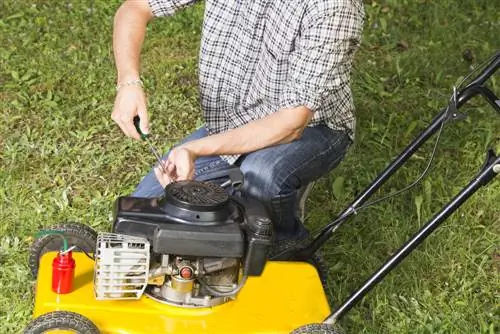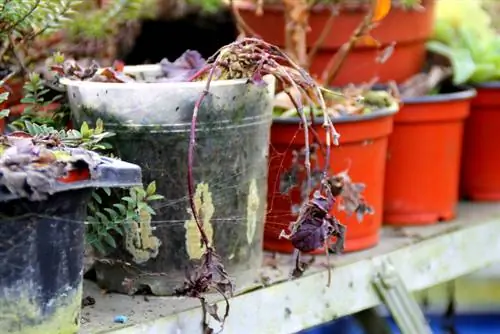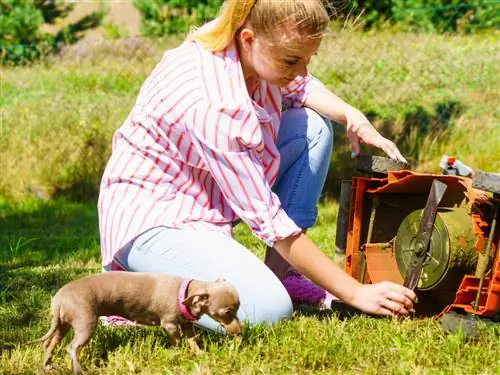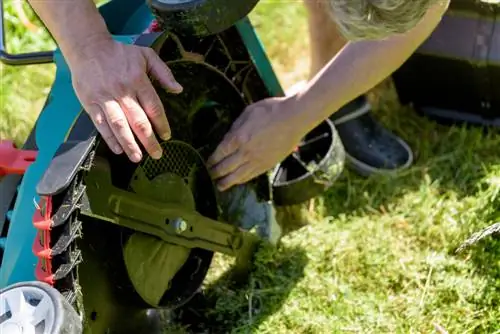- Author admin [email protected].
- Public 2023-12-16 16:46.
- Last modified 2025-06-01 06:02.
If the lawn mower won't start, sputters or smokes, a dirty carburetor is the culprit. If you have gross motor skills, you can also solve the problem yourself. This guide explains how to properly clean the carburettor on a petrol lawnmower.
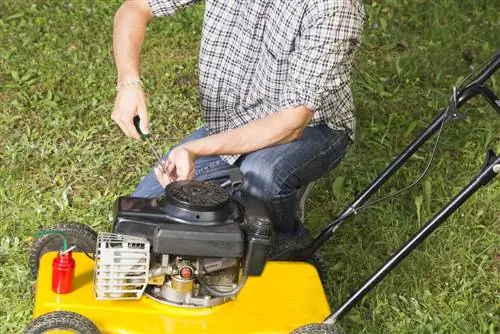
How do I clean my lawnmower's carburetor?
To clean a lawnmower's carburetor, you will need a repair kit, carburetor cleaner or mineral spirits, compressed air, rags and tools. Remove the carburetor, soak all parts and clean jets and lines with compressed air. Dry and assemble the carburetor before adjusting its settings.
Material requirements and tools
Although the specific structure of a carburettor depends on the lawnmower model, cleaning requires largely the same steps. Competent manufacturers offer repair kits for do-it-yourselfers with all important spare parts, such as seals and O-rings. Please provide the following materials and tools:
- Lawnmower carburetor repair kit (€10.00 on Amazon)
- Carburetor cleaner or mineral spirits
- Compressed air source
- rag
- Vat or large bucket
- Screwdriver, torque wrench
If the manufacturer of your lawn mower does not offer a repair kit, purchase the necessary spare parts, such as sealing rings, from the nearest hardware store.
Step-by-step instructions - How to clean the carburettor
First pull off the spark plug cable. For the sake of caution, keep the cable a safe distance from the spark plug. Then remove the air filter and turn off the fuel tap. On engines without a fuel valve, the fuel line is ideally clamped using a clamp. How to proceed:
- Loosen the mounting screws while the carburettor is still connected to the speed controller
- If you have any problems, check the positions of the mounting screws in the manual
- Do not remove the speed governor springs until their position has been marked
- Filling mineral spirits into a tub
- Soak the carburetor and all plastic and metal parts in it
- Alternatively, rub or spray the components with carburettor cleaning agent
While the lawnmower carburetor is soaking, treat nozzles and lines with compressed air to remove debris. The air filter and spark plug should also be cleaned at this time. Wipe the carburetor and any remaining intact components dry with a clean rag. Please replace damaged or worn parts.
Installing and adjusting the carburetor - this is how it works
Install the clean carburettor and cleaned air filter, reconnect the spark plug cable to the spark plug and open the fuel tap. Please refer to the manufacturer's operating instructions to understand the exact positions of the components. In the last step of the cleaning process, you readjust the carburettor. This is how it works:
- Starting the lawnmower
- Let it run for a few minutes so that the engine warms up
- Turn in the adjusting screw for regulating the engine speed 1 to 1 1/2 turns
- Engine speed increases
- Adjust the idle mixture adjustment screw so that the engine runs smoothly and evenly
Finally, the engine speed is fine-tuned for the perfect idle speed. Ideally, you have a tachometer for measuring engine speeds available for this purpose. The optimal values range between 1200 rpm for an engine with a cast steel cylinder liner up to 1750 rpm for an engine with an aluminum cylinder.
Tip
A carburettor stays clean longer if you start the lawn mower correctly. As soon as the engine has warmed up, the fuel supply should be throttled using the throttle lever (choke). Otherwise, harmful deposits will form in the carburetor and other components because not all of the gasoline is burned.

